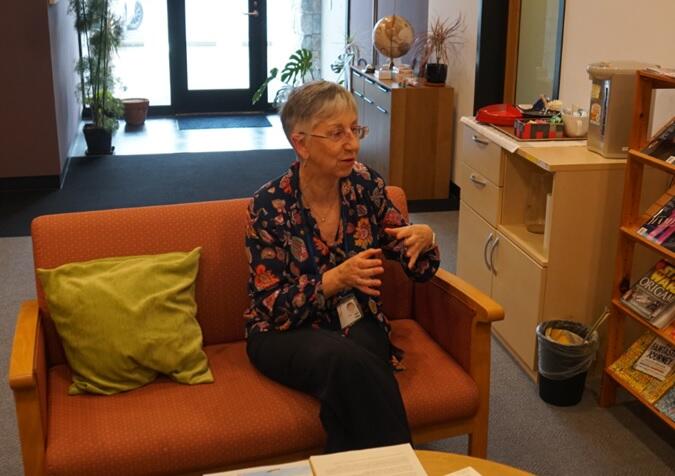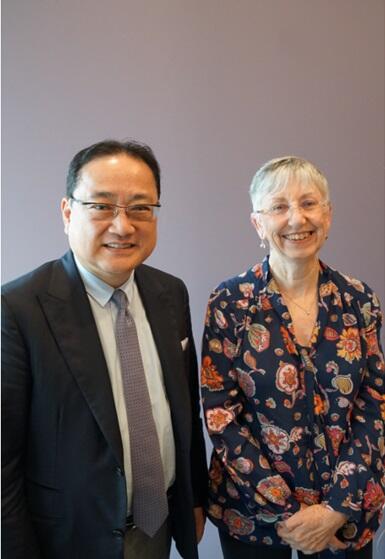Promoting international research mobility and creating international talent circulation is an essential condition for robust research and development. To this end, it is important to internationalize the research ecosystem, promote international human resource exchange, and ensure that Japan is firmly integrated into the international brain circulation network. Under this special topic, we will introduce the current status and challenges of Japan's research efforts to promote international brain circulation to produce outstanding research results as well as the attractiveness of Japan's research environment, which is the key to attracting foreign researchers, through a series of interviews with relevant people in the field. In this interview we spoke to Dr. Gail Tripp, leader of the Children's Research Center at OIST.
Nestled into a picturesque office on the ground floor of Lab 4 at the Okinawa Institute of Science and Technology (OIST) one can find the Children's Research Center. International joint research into neurodevelopmental disorders is undertaken here between Japan, New Zealand, Brazil, Britain and Belgium, with a particular focus on attention deficit hyperactivity disorder (ADHD). Leading this research center is Dr. Gail Tripp, a clinical psychologist and professor at OIST, who shared some time with us to speak about her research, her experience as an international researcher in Japan and the importance of the global circulation of people and knowledge for positive research outcomes.

From southern New Zealand to tropical islands in Japan
Tripp was born and raised in Central Otago, New Zealand. She attended the University of Otago, in Dunedin city, as an undergraduate student, moving on to complete a PhD, and then worked at a large public hospital as a clinical psychologist after graduation. Following this, she returned to the University as a faculty member, where she taught graduate and undergraduate courses in abnormal psychology and graduate courses in child assessment and intervention.
Her husband, also an academic, had many connections with researchers in Japan, and while they were employed at the University of Otago, he suggested they move to Japan for work. Tripp said that she held many stereotypes at the time that made her hesitant to undertake such a move.
"I'll be perfectly honest in saying that I held some stereotypes. Even in New Zealand, as a female scientist, there were not very many women in my department. I was a new mother, and had feelings along the lines of 'I am going to move with a small baby to a country where I don't speak the language and am not sure that I'll be able to work.'
Things changed a few years later when another chance to move to Japan arose. After being introduced to OIST and its vision, Tripp and her husband gave up their permanent positions at the University of Otago and made the move to the sunny islands of Okinawa together with their two children. Now, after 16 years of living and working in Japan, Tripp says with a smile that Okinawa has become home. "We bought a house here in Okinawa, we are here to stay."
Tripp's story serves to highlight both the importance of the international movement of researchers, but also shows some of the difficulties that are faced by those looking to do research overseas, such as preconceptions and stereotypes, language barriers, and the short‐term, results focused nature of academia.
A global issue with diverse local approaches
Tripp's background is in clinical psychology and neuroscience and her research falls under the broad umbrella of 'child mental health.' "All of the research being carried out in the lab focuses on different aspects of understanding the nature of ADHD and trying to identify the causes of the problems facing children with the disorder. This knowledge is then translated into practice to try to enhance the wellbeing of children and families," Tripp stated, describing in detail the kind of research she and the team at the Children's Research Center are undertaking.
Developmental disorders such as ADHD are seen across the world. However, cultural and societal differences have led to different responses to children presenting with symptoms of ADHD. Japan in particular serves as an interesting place to undertake research due to aspects of its culture that highlight unity, harmony, calmness and group coherence. Tripp spoke about this, saying, "Symptoms of ADHD are not always consistent with these goals and can make it harder for children with the disorder to fit within Japanese culture compared with their peers. Children with ADHD respond to reward, the loss of reward and punishment differently. We want to understand the neurobiology of these differences. We also spend a lot of time educating people to understand that there is no shame in having ADHD." Members of the Childrens Research Center/Human Developmental Neurobiology Research unit have developed a parenting program for Japanese mothers, and they are carrying out research looking at how to use technology and social platforms to reach the wider community and help with the issues they are facing. They are also looking at ways to support parents and teachers together.
Joint research with colleagues in Brazil has allowed a closer look at how ADHD is understood and addressed in different countries and cultures. Speaking about this, Tripp said "Cultural differences mean that the specific concerns of parents and teachers may be different to what is seen in Japan." This can be linked to the groups research on how children with ADHD response to positive feedback and the use of reward such as praise, differs across cultures. "In many western countries praise, or reward, is used frequently and can be used to support children to engage more in adaptive behaviors. In other cultures, for example here in Japan, reward is used more sparingly. A challenge we face is helping parents and teachers to understand that praise and positive reinforcement is a very effective way of changing behavior. You don't need to use punishment if you can use positive reinforcement," Tripp commented regarding cultural biases and impacts on how ADHD is responded to worldwide.
These examples of joint research and deepening understanding of the global responses to ADHD really highlight how global research and the circulation of talented researchers can advance research outcomes and provide solutions to problems faced by society.

The future of child developmental research
The underlying causes of ADHD are still not well understood. "Like any neurodevelopmental or psychiatric disorder, it's going to be multiply determined," Tripp stated. "We have proposed a theory of altered reward sensitivity, called the dopamine transfer deficit, which we think explains the symptoms of ADHD in at least some individuals who present with the disorder. ADHD is more common in relatives of those with the disorder, but the true cause is not that simple. It isn't like typical examples, such as inheriting hair or eye color." These uncertainties make the treatment of the underlying causes of the disorder challenging.
One form of treatment is the use of medications. However, these do not serve to solve the underlying issues and only treat the symptoms of the disorder. There can also be side effects.
Changing attitudes towards mental health, the advancement of technology and proliferation of social media in society have all resulted in changes to how research into developmental disorders and ADHD has progressed. Looking at programs developed through OIST, Tripp said, "We are looking at how we can use technology or applications such as WhatsApp to make more general parenting skills available to parents here in Japan and Brazil. Brazil has a shortage of therapists trained in behavioral management techniques. It's not easy for families to actually reach out and get services. In Brazil, just as here in Japan, there is stigma related to reaching out to services."
Dissemination of information and treatments is a big issue facing the field at the moment. Currently, behavioral treatment for ADHD is not covered by the Japanese medical health insurance system, and parent training and other associated ways of tackling the issue can be hard to access. That said Tripp noted there is much more support for parenting programs in Japan now compared to when she joined OIST 16 years ago. Tripp and her team are investigating a wide range of methods to make it easier for the local Okinawan community, and other areas of Japan, to access support through apps and community focused programs.
A holistic approach is required for the end goal of treating the underlying causes of the disorder, and the research Tripp does now is a great model for how this may be solved in the future. "The work that I do now marries [neurobiology and clinical psychology] very nicely and it allows me to work both with my neuroscience colleagues and with my clinically qualified colleagues." These joint efforts are a promising path towards a solution to a long‐standing societal challenge.
"The long‐term plan is to take basic research and to implement it to enhance the lives of people in Japan and beyond, because the work that we do is not only relevant to Japan, but we also do work that is internationally meaningful. We just happen to be doing it in Japan," Tripp stated proudly.
OIST: A hub for research excellence
When we asked Dr. Tripp about how OIST has impacted her work as a researcher, she had nothing but positives to share. "I am incredibly fortunate to be here at OIST. One of the things that OIST does offer is internal subsidy funding, which gives us a degree of continuity that you don't always have with entirely grant funded research. When I was in New Zealand, we had some internal funding, but I was always writing grants." The high trust funding system that OIST uses has been of great benefit to Tripp and her research, and OIST's unique system is one of the reasons that allowed her to make the move to Japan as a researcher.
She was also very positive about the students that come to study at the institute. "There's no university without students and OIST has an incredible range of them. They are bright. They take a chance on us, bring new ideas, and they stop you from getting stuck. They don't let you just stay in your comfort zone or in your research track, and bring you into new areas of research."
A highlight of OIST is the number of foreign nationals working and studying on campus. Tripp mentioned that her unit alone has members from Poland, Sri‐Lanka, Belgium, the US and Israel as well as from Japan. "We have got a JSPS (Japan Society for the Promotion of Science) fellow joining us as a post‐doc at the beginning of next month, and she is really interested in having a more international perspective. We are hoping that two or three years spent with us will give us the opportunity to introduce her to many of our international colleagues." OIST as a whole has members hailing from an even larger number of countries.
To sum up her experience, Tripp said, "Do we regret coming to Japan? Absolutely not, and we are not planning on leaving anytime soon. Has it been good for my research? Yes. There were some challenges such as getting started and setting up a new lab. But we persevered, we got there. I am really proud of the work that we do, of the people in our team, and watch out because we are just going from strength to strength. We have been very fortunate that OIST and Japan have allowed us to do that."

Provided by OIST
International brain circulation and advice to future researchers
With respect to the international circulation of talent which may benefit Japan, including OIST graduates who stay and get jobs in Japan, Tripp tried to illustrate the situation among her students at OIST, saying "The student that I am co‐supervising in Belgium cannot wait to return to Japan. She is applying for many fellowships because she was so engaged in Japan and really wants to come back. My student from Poland is working very hard at her Japanese language because she wants to stay in Japan. One of the students that I mentored from the very first class, a data science student, is now back working in Japan. I think Japan gets under their skin and, if they have to leave, they want to come back."
We finished the interview by asking Tripp for some advice for young researchers looking to get into child developmental research or looking to work in other fields in Japan. She responded, "I think they shouldn't be afraid, and they should be willing to take a chance. I think the thing that universities need to think about is making sure that it's not too difficult for them to move to and live in Japan. OIST has worked hard to support the lives of people outside of the labs so that it is possible for people to move here, for example we have an onsite bilingual childcare facility attended by more than 150 children of OIST staff and students."
"I think we need to help people recognize that Japan is opening up because people do have a perception that it can be difficult to move to and work in Japan". She continued, "I think we do need to show that Japan can be a great place to live and work, but also to recognize that we need to help people establish their lives in Japan."
Tripp emphasized the importance of helping those coming from overseas to not be afraid of the new experiences, by helping them with language lessons, local administrative procedures, and so on, so that they can focus on the important things such as their research. Allowing international talent to come to Japan, continue to do excellent research and focus on translating their basic science into applications in society is important.
International researchers working in Japan, particularly those at OIST, serve as a great example of the benefits of international brain circulation. The transfer of these researchers into Japan, the work they undertake here, both with local scientists and through global joint research, and then their movement into local industry here, or on to further overseas work is of great benefit to Japan and globally. We have high expectations for further contributions of Dr. Tripp and the Children's Research Center/Human Developmental Neurobiology unit to science research in Japan and the Okinawan community.
(Interviewer: Yoshihiro Higuchi, Director for Global Strategic Issues, JST)

Profile
Gail Tripp
Professor, Okinawa Institute of Science and Technology Graduate University
After completing an honors degree in psychology and gaining qualifications in clinical psychology and a PhD in neuroscience at the University of Otago, New Zealand, she took up a position as a clinical psychologist in a large public hospital. Following this she returned to an academic position in the Psychology Department at the University of Otago. She took up a role at OIST from 2007 as a principal investigator and now serves as leader of the Children's Research Center.
<About OIST>
The Okinawa Institute of Science and Technology (OIST) is a graduate university dedicated to conducting world-leading research, growing the next generation of scientific leaders, and fostering innovation and sustainable economic growth in Okinawa. Since its founding 11 years ago, OIST has gained recognition in the international scientific community. When normalized for size, the university ranks among the top ten institutes in the world for high-quality and high-impact scientific research outputs.
OIST homepage: https://www.oist.jp/
Produced by the Science Japan Editorial Team




